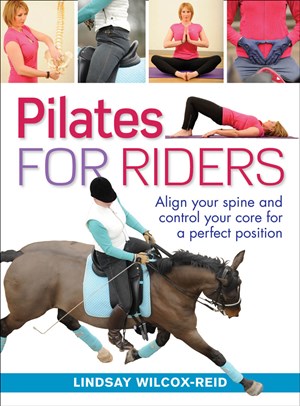By Lindsay Wilcox-Reid
Softcover, 192 pages, published by Trafalger Square Books.
Available at HorseBooksEtc.com or by calling (800) 952-5813.
Reviewed by Mary Daniels
I not only read this book to review it, I practiced many of the exercises in it, drawn in by its promises. I had been fighting activity-limiting lower-back pain and sciatica for several years. This book wastes no time in cutting to the chase as to how to build a new core or recoup a lost one.

The foreword by British Olympian Laura Bechtolsheimer is a powerful personal testimonial as to how Pilates can make a better balanced, more effective and elegant rider. “Using Pilates exercises tailored for riding allows you to learn to switch on the right muscles and turn off the wrong ones, and to be aware of which you want to use. This has helped me to ride more of my big, strong horses without any backache or side effects,” she writes.
The author, Lindsay Wilcox-Reid, is a British Dressage Accredited Trainer and a Level 3 Pilates instructor, accredited with the Register of Exercise Professionals, whose specialty is teaching posture and position. She has an inspired ability as an instructor to harmoniously bring together the biomechanics of the muscular systems of both horse and rider so that even the biologically challenged can get it.
Chapter I introduces us to “Pilates Principles for Life,” an interesting history of how Joseph Pilates developed this series of exercises with the aim of building essential strength and flexibility. It was encouraging to hear that his own wife, Clara, was able to overcome her chronic arthritis by practicing her husband’s exercises.
Pilates’ extensive study of anatomy and biomechanics meant that, while focusing first on the core muscles deep within the torso, he was able to target either strengthening or stretching virtually every muscle in the human body. The author describes muscles I did not even realize I have. But of principle importance is her focus on the pelvic-floor muscles and the transverses abdominus, resembling a wide belt that wraps around your lower back and stomach. She describes clearly and with exactitude just how to activate both of these muscle groups to give support to your spine and achieve greater strength.
The illustrations of pelvises and muscle systems are well done but probably a bit over the top for most readers who just want to ride better, or relieve pain. But it is just this kind of detail that makes the book an indispensable tool for dressage trainers who are trying to improve their pupils’ positions and their influence on their horse.
One of the most fascinating chapters is “Mysteries Unravelled—the Half Halt.” Many trainers, she writes, tell their pupils to half halt their horses without even telling them what a half halt actually is, what it is supposed to achieve and precisely what they have to do with which parts of their bodies to do it. Veteran of a baker’s dozen of instructors in frustrated attempts to seek the perfect half halt, I have to agree. The author describes exactly what seat muscles to active (transverses abdominus and gluteus maximus) and what leg muscles to activate (adductors) and what hand muscles to activate (squeeze your shoulder blades together, weight your elbows and squeeze your fists).
The floor exercises toward the back of the book are marked with a blue horseshoe if they are basic introductory exercises, which I have stuck to for the most part. Exercises marked with a green hunt cap are the next step after you have worked at the blue-horseshoe level for a while. Advanced exercises are marked with a pink top hat.
I can say that within a week of doing the Pilates stretches, I was able to reduce pain and stiffness by as much as half, and I could forego stomach-churning aspirin or ibuprofen. Even better, when I follow the acupuncture, which alleviates enough pain so I can move, with the Pilates exercises, I am able to extend the time between visits to the acupuncturist. It’s definitely working, though I would rather not pinpoint exactly which exercises helped me the most with mobility, as I think it is going to be different for each individual. If you have an injured back, I strongly suggest you get input from a professional before trying anything. But the basic stretches in this book are a head start on a better future.











